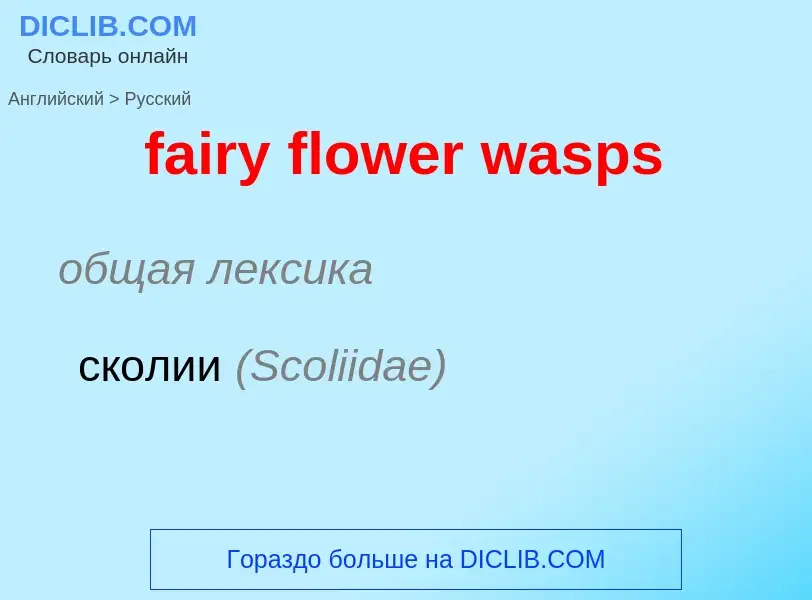Traduzione e analisi delle parole tramite l'intelligenza artificiale ChatGPT
In questa pagina puoi ottenere un'analisi dettagliata di una parola o frase, prodotta utilizzando la migliore tecnologia di intelligenza artificiale fino ad oggi:
- come viene usata la parola
- frequenza di utilizzo
- è usato più spesso nel discorso orale o scritto
- opzioni di traduzione delle parole
- esempi di utilizzo (varie frasi con traduzione)
- etimologia
fairy flower wasps - traduzione in russo
общая лексика
сколии (Scoliidae)
['fe(ə)ririŋz]
общая лексика
"ведьмины кольца"
кольца плодовых тел грибов (Basidiomycetes)
«ведьмины кольца» (из грибов, растущих кругами на лужайках)
общая лексика
опёнок луговой (Marasmius oreades)
Definizione
Wikipedia

The Mymaridae, commonly known as fairyflies or fairy wasps, are a family of chalcidoid wasps found in temperate and tropical regions throughout the world. The family contains around 100 genera with 1,400 species.
Fairyflies are very tiny insects, like most chalcidoid wasps, mostly ranging from 0.5 to 1.0 mm (0.020 to 0.039 in) long. They include the world's smallest known insect, with a body length of only 0.139 mm (0.0055 in), and the smallest known flying insect, only 0.15 mm (0.0059 in) long. They usually have nonmetallic black, brown, or yellow bodies. The antennae of the females are distinctively tipped by club-like segments, while male antennae are thread-like. Their wings are usually slender and possess long bristles, giving them a hairy or feathery appearance, although some species may have greatly reduced stubby wings or lack wings altogether. They can be distinguished from other chalcidoids by the H-shaped pattern of sutures on the front of their heads.
Fairyflies are among the most common chalcidoids, but are rarely noticed by humans because of their extremely small sizes. Their adult lifespans are very short, usually only a few days. All known fairyflies are parasitoids of the eggs of other insects, and several species have been successfully used as biological pest control agents.
The fossil record of fairyflies extends from at least the Albian age (about 107 myr) of the Early Cretaceous.


![''[[Acmotemnus luteiclava]]'' (female) ''[[Acmotemnus luteiclava]]'' (female)](https://commons.wikimedia.org/wiki/Special:FilePath/Acmotemnus luteiclava female.jpg?width=200)
![''[[Arescon]]'' sp. (female) from [[Thailand]] ''[[Arescon]]'' sp. (female) from [[Thailand]]](https://commons.wikimedia.org/wiki/Special:FilePath/Arescon (fairyfly, Thailand).jpg?width=200)
![John Curtis]], c. 1840 John Curtis]], c. 1840](https://commons.wikimedia.org/wiki/Special:FilePath/Britishentomologyvolume3Plate411.jpg?width=200)
![[[Compression fossil]] of ''[[Gonatocerus greenwalti]]'' from [[Montana]] [[Compression fossil]] of ''[[Gonatocerus greenwalti]]'' from [[Montana]]](https://commons.wikimedia.org/wiki/Special:FilePath/Gonatocerus greenwalti Fossil.jpg?width=200)
![''[[Gonatocerus triguttatus]]'' laying its eggs in [[glassy-winged sharpshooter]] eggs embedded in a leaf ''[[Gonatocerus triguttatus]]'' laying its eggs in [[glassy-winged sharpshooter]] eggs embedded in a leaf](https://commons.wikimedia.org/wiki/Special:FilePath/Gonatocerus triguttatus laying eggs in glassy-winged sharpshooter eggs.jpg?width=200)
![A [[Malaise trap]] A [[Malaise trap]]](https://commons.wikimedia.org/wiki/Special:FilePath/Malaise trap.jpg?width=200)
![''[[Myanmymar aresconoides]]'' from the [[Burmese amber]] ''[[Myanmymar aresconoides]]'' from the [[Burmese amber]]](https://commons.wikimedia.org/wiki/Special:FilePath/Myanmymar aresconoides.jpg?width=200)
![Atlantic]]. Scale bar = 1 mm Atlantic]]. Scale bar = 1 mm](https://commons.wikimedia.org/wiki/Special:FilePath/Mymarilla wollastoni.jpg?width=200)

![''[[Clitocybe nebularis]]'' in part of ring ''[[Clitocybe nebularis]]'' in part of ring](https://commons.wikimedia.org/wiki/Special:FilePath/Clitocybe nebularis group.jpg?width=200)
![mycelia]]. mycelia]].](https://commons.wikimedia.org/wiki/Special:FilePath/FairyRingSchoolField.jpg?width=200)


!["Come, now a roundel." One of [[Arthur Rackham]]'s illustrations to Shakespeare's ''[[A Midsummer Night's Dream]]''. "Come, now a roundel." One of [[Arthur Rackham]]'s illustrations to Shakespeare's ''[[A Midsummer Night's Dream]]''.](https://commons.wikimedia.org/wiki/Special:FilePath/Rackham fairy ring.jpg?width=200)
![''Faun and the Fairies'' (1834) by [[Daniel Maclise]] ''Faun and the Fairies'' (1834) by [[Daniel Maclise]]](https://commons.wikimedia.org/wiki/Special:FilePath/Daniel Maclise - Faun and the Fairies.jpg?width=200)
![''Come unto These Yellow Sands'' (1842) by [[Richard Dadd]]. Images of nude and semi-nude fairies dancing in rings became popular during the Victorian era. ''Come unto These Yellow Sands'' (1842) by [[Richard Dadd]]. Images of nude and semi-nude fairies dancing in rings became popular during the Victorian era.](https://commons.wikimedia.org/wiki/Special:FilePath/Richard Dadd - Come unto These Yellow Sands.jpg?width=200)
![1880}}) by [[William Holmes Sullivan]] 1880}}) by [[William Holmes Sullivan]]](https://commons.wikimedia.org/wiki/Special:FilePath/William Holmes Sullivan - The Fairy Ring; the Enchanted Piper.jpg?width=200)
![Richard Doyle]], 1875. Richard Doyle]], 1875.](https://commons.wikimedia.org/wiki/Special:FilePath/Fairy Rings and Toadstools by R Doyle.jpg?width=200)
![Woodcut of a fairy-circle from a 17th-century [[chapbook]] Woodcut of a fairy-circle from a 17th-century [[chapbook]]](https://commons.wikimedia.org/wiki/Special:FilePath/Fairies dancing in a ring woodcut.png?width=200)
